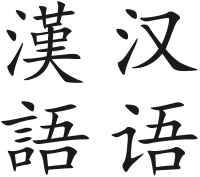IsiShayina
IsiShayina singulimi weShayina.
| IsiShayina | |
|---|---|
|
汉语/漢語 or 中文 Hànyǔ or Zhōngwén | |
 Hànyǔ (Chinese) written in traditional (left) and simplified (right) characters | |
| Native to | IShayina, Taiwan, Singapore, Hong Kong, Macau, Malaysia, IMelika, IKhanada, I-Indonesia, and other places with significant overseas Chinese communities |
| Ethnicity | Han Chinese |
Native speakers |
unknown (1.2 billion cited 1984–2001)[1] |
|
Sino-Tibetan
| |
Standard forms |
Putonghua (Standard Mandarin)
|
| Dialects |
Wu (incl. Shanghainese)
|
| Chinese characters, zhuyin fuhao, Latin, Arabic, Cyrillic, braille. Ancient use of 'Phags-pa script. | |
| Official status | |
Official language in |
|
Recognised minority language in |
|
| Regulated by |
|
| Language codes | |
| ISO 639-1 | zh |
| ISO 639-2 |
chi (B) zho (T) |
| ISO 639-3 |
zho – inclusive code Individual codes: cdo – Min Dong cjy – Jinyu cmn – Mandarin cpx – Pu Xian czh – Huizhou czo – Min Zhong gan – Gan hak – Hakka hsn – Xiang mnp – Min Bei nan – Min Nan wuu – Wu yue – Yue och – Old Chinese ltc – Late Middle Chinese lzh – Classical Chinese |
| Glottolog | sini1245 |
| Linguasphere | 79-AAA |
 Map of the Sinophone world Legend: Countries identified Chinese as a primary, administrative, or native language Countries with more than 5,000,000 Chinese speakers Countries with more than 1,000,000 Chinese speakers Countries with more than 500,000 Chinese speakers Countries with more than 100,000 Chinese speakers Major Chinese-speaking settlements | |